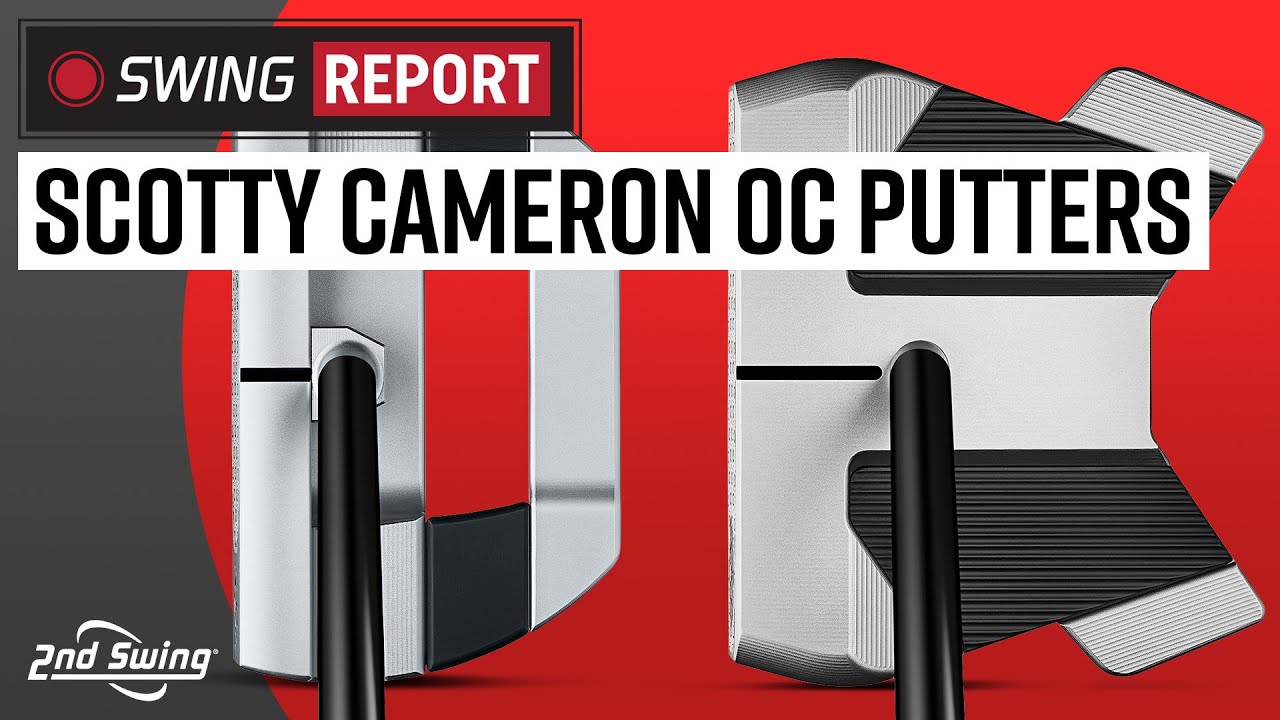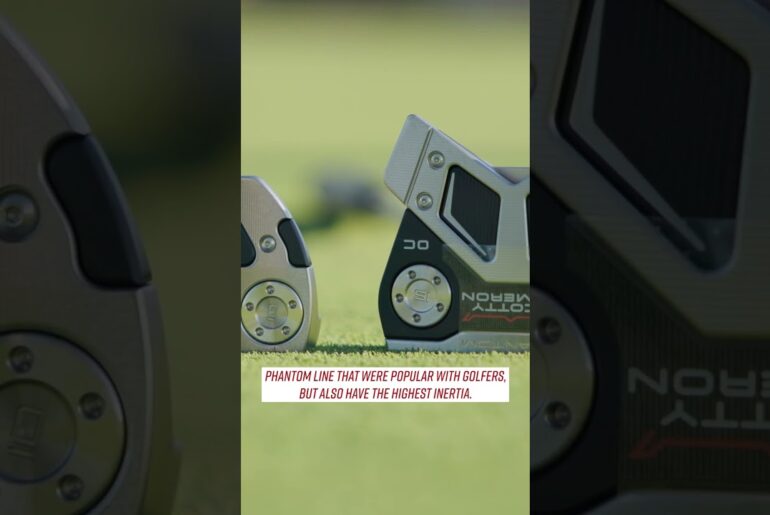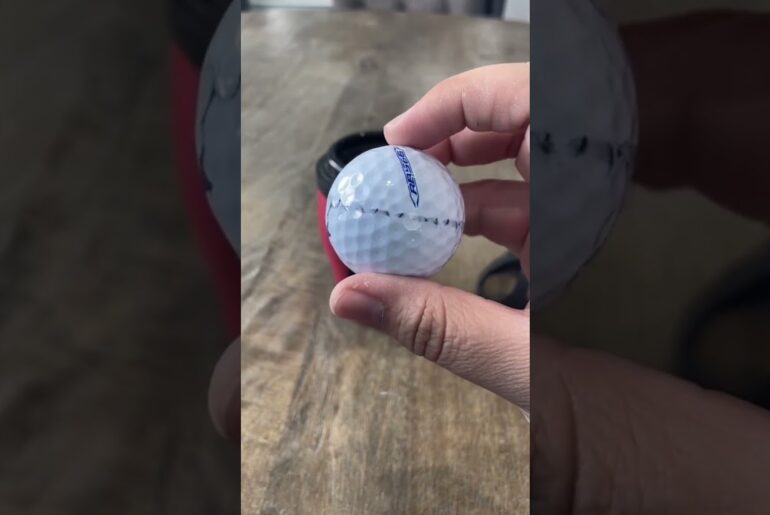The new Scotty Cameron OC Putters from Titleist feature low torque performance blended with Scotty Cameron’s exceptional craftsmanship. With the low torque “Onset Center” design, the Scotty Cameron OC putters promote a square-to-the-path delivery while keeping golfers connected to the putting stroke. There are two models in the Scotty Cameron OC putters design, the Scotty Cameron Phantom 11R OC and the Scotty Cameron Studio Style Fastback OC.
0:00 Intro, Tech, and Key Details
5:26 Testing
12:50 Final Thoughts
In this edition of the Swing Report, 2nd Swing’s Drew Mahowald is joined by Austie Rollinson, Senior Director of R&D for Scotty Cameron putters, at Titleist Performance Institute to review and test the new Scotty Cameron OC putters, including the Scotty Cameron Phantom 11R OC and the Scotty Cameron Studio Style Fastback OC.
Schedule an award-winning 2nd Swing Tour Van club fitting today: https://fitting.2ndswing.info/schedule-now/
FOLLOW 2ND SWING GOLF ON SOCIAL MEDIA:
Facebook: https://www.facebook.com/2ndSwingGolf
Twitter: https://twitter.com/2ndSwingGolf
Instagram: https://www.instagram.com/2ndswinggolf/
TikTok: https://www.tiktok.com/@2ndswinggolf
Hey golfers, I’m Drew Mold of Second Swing Golf. We’re here at TPI. I’m joined by Austy Rollinsson, senior director of R&D for Scotty Cameron putters. Uh because we have a couple new models here, Asty. Um really cool look and feel and design already. I can tell with these the Scotty Cameron OC. So, first thing I wanted to ask you about OC onset center. What is the story behind that design? What is the purpose of this whole thing? We’ve been testing these on tour for uh about a year and a half now. Obviously, there’s been a trend for these uh onset center low torque, zero torque type putters. And we really took our time looking at how players interact with these designs. And so our first fora into creating these low torque putters are OC. And we see this as basically a different Hzle style within the Phantom line and within the Studio Style line to really help a variety of golfers in addition to all of our other Hoszle styles. Yeah, because that’s uh there’s one model here from Studio Style, one from Phantom. And so I kind of wanted to that’s another question I had for you was we’ve got Fastback and we have the 11. What was it about these two that kind of make them the sort of that now have the OC variation to them, if you will, uh within the Scotty Cameron lineup? where they’re both basically the head shapes in the studio style and the uh Phantom line that were popular with golfers, but also have the highest inertia. And I think those are the type of players looking for a kind of low torque type of product are ones that want more forgiveness. Y the OC kind of brings a forgiving a stable feel in the stroke while these head shapes give you the stability if you’re not exacting where you hit the putter on the face, the ball in the face. Right. And one thing too that you mentioned actually before we hit record was the shaft. And so you had a a comment about that and why the shaft is this darker color. So particularly about how how it looks at a dress. Can you kind of walk me through that again and tell the viewers what that decision was like? Yeah, we put a lot of mind mindset into the aesthetics of these or what are they going to look like over the ball? And we found that when you have a chrome shaft and you have this alignment mark right on the front when the shaft is connected in the back, you don’t really see too many reflections in it, but it’s that close to that alignment line. You see the reflection. So going black really gives you a cleaner look, very little distraction, and it’s really cool looking as well. It is. It is very cool looking. Uh specifically as it pertains to the 11. So it’s, you know, the 11R is what it’s, you know, technically called because it’s slightly different. I think R is kind of hinting that it’s more rounded maybe. So kind of what went into that versus maybe the other 11 shapes within Phantom and and what are golfers going to see with that specifically versus um I guess the other 11s. Yeah, the the R stands for rounded. And so when we first came out with the Phantom 11, it was very angular. Scotty likes very angular shapes in his putters. But as we started working with tour players on the Phantom 11 and the Phantom 9, there are some players that line up rounded shapes better than angular shapes. And so the Phantom 9R was one we had in the Phantom Black that had more rounded features on it. So on this Phantom 11, we’ve also been making these from players with a little more rounded toe and heel and even the wings are a little rounded, just a softer look at a dress and decided to bring that because it’s been popular on tour, bring it into this, make the OC version the rounded version. Sure. Now, last thing I got for you is the face millings on these. So, we’ve got that chain link uh design. Uh there’s the insert on the fastback here, and it’s actually the entire face of the Phantom 11 R. Uh what has been the feedback on this design? Thanks. I think it’s it’s a pretty kind of new studio style was the sort of lineup that it was, you know, implemented into. Um, what’s been the feedback like for that? The feedback’s been great and we had our kind of small limited launch of the Phantom Black putters where we put this chain link milling across the face. Had a lot of good feedback on that. Even have some out on tour. We had tour players requesting that chain link milling in some of these Phantom mallets. It really gives just less surface contact, a softer sound and feel. So, we wanted to bring that sound and feel into this as well because feel is probably the utmost importance. We wanted to create these OC designs with more feel than some of the other products out there. So, the chain link milling has a lot to do with that. The metal face, the steel face has a lot to do with that Scotty Cameron sound. You know, even the choice of the shaft, it’s got a little bit, it’s not a super super stiff shaft, so you still have some head feel. And the other aspect, when you get rid of the torque around the shaft, you still have torque that you’re feeling the hands doing to the weight. And we have found through testing with players, I’ve made these in the past, um, 10, 15 years, these type of zero torque putters, you need to add a little bit more head weight to get some of the head feel back. So, we’ve increase the weight on these heads, 15 grams, to get some of that stability into the lie plane that’s perpendicular to the the face and the path. And that’s what’s going to give the golfers the stability and the feel of stability throughout the stroke. Yeah. See, that’s that scientific approach that none of us or I certainly would never have think thought of. But, uh, okay, this is great. I’m excited now cuz we’re going to do a little bit of testing here. We’re out on the We have, you know, the green right at TPI. We’ve got, um, a beautiful afternoon and evening. I’m excited to hit a few putts here with these. Yeah, likewise. All right, Asty. Uh, I’ll start here with the Fastback OC. And um you mentioned this is kind of the uh of the studio style lineup. This is probably you know one of the higher MOI or maybe more forgiving models. Yeah, this one and the the squareback. Yeah, squareback’s probably a little higher inertia than this. This one has proved more popular in the market I think just because of again that rounded versus square look. Sure. People like this rounded look of this uh this product. So that’s why we brought this into the line. Yeah. And then one thing too I wanted to ask you about was, you know, as I set up here, there is it does seem like it’s leaning a little bit. Yeah, we have subtle just one degree of shaft. We saw some companies go two degrees and as much as three degrees. We decided to just go one degree because it’s enough to get your hands kind of in that place kind of over the face where players they’re used to putting them there, right? But not enough where it starts looking awkward. Yeah. Yeah. It’s It’s like And I actually like how, you know, it is a little bit different if you’re used to the heel shaft. Um, but I like how comfortable it still sits for you and uh it’s pretty seamless, at least for me as someone who hasn’t played with the a center shafted type of look before. I mean, one for one right there. I would I noticed I didn’t hear it wasn’t like super loud or anything either. Yeah, the studio carbon steel insert’s been really popular as well, giving you that soft feel at impact. And if you notice, this has a little different hoszle type position on it. We we created this unique kind of OC hoszle on the back, mainly to keep that attachment point separate from the top line. We wanted to have a distinct top line and then have this attached up high because that enables that shaft to be right behind that center part. Got it? if if if it goes down and goes into the bottom of the cavity, then the shaft gets too far toward and starts looking awkward. So, a lot of a lot of thought went into making sure that the look at a dress is as comfortable as possible while still keeping the the low torque uh characteristics. I didn’t even notice that cuz like I I just assumed it was down into the cavity, but it’s not. Interesting. This is rolling pretty well for me right now. But yeah, I because I’m and I’ve always been one too where I think for the most part I prefer something that’s not doesn’t feel or um doesn’t it it’s not super loud, right? I prefer something a little softer. U which you know when it’s a when it’s a mil and there’s not that there’s some there’s companies out there putters out there that have super soft inserts which maybe to a degree is maybe too soft but yeah this one’s it’s it’s soft feel but you still have that responsiveness of metal. So you Yeah, it’s that sounded impact really helps you judge distance, gives you distance control. So making it sound correct is almost as good is is paramount for these types of products. I know that that’s player dependent to a degree, but um that’s I mean, hey, I’m three for three with Yeah. setups here. So yeah, that’s all right. Should we switch here? Let me try this. So there’s the 11 ROC. See, now I also, you know, I’ve I’ve played I’ve played blades, I’ve played mallets, but like I really like and I have liked just the way the alignment lines have set up on this 11 with the various um you know, with within the Phantom lineup as a whole, but especially the 11 head. It just seems like it’s so easy to to line yourself up with it. Yeah. The original 11 had the arrow alignment feature on there. Yeah. So when we went with the Phantom Black, we went more subtle and just had had the two lines like we have the Phantom 9. So this we’ve gone even more subtle uh with just the indication of the line. It just ends at the shaft connection, but you still have the steel part of this T alignment going the full length. So you do get the advantage of those parallel lines uh for your target line going down. Yeah, it’s almost it kind of, you know, in my in my brain anyway, it almost paints a picture of an arrow just like just go this way, you know? Right. Right. And that’s the whole idea of that putter. It’s just a little more subtle than than the previous phantom. Definitely a little Is it Would it be fair to say it’s a little softer or is that maybe incorrect? Would it or do you would you expect this one to be a little little firmer feeling? It’s a taste thing for a lot of players. Some players hear it more loud, some people hear it more softer. It’s Okay. Everyone’s ears are a little different and what frequencies they pick up. That one was Yeah. It’s almost like like that one I almost felt like, you know, when you make perfect contact with like an iron or something and you barely feel anything. That’s kind of what that was. Yeah. And this is, you know, a solid solid mallet, you know, where this one has a top line, a cavity, a thin wall, a thin wall here. So, the sound is going to be a little different. Just the whole putter head’s going to make noise where that one’s got a lot of aluminum in it too, which helps with the sound. That one I actually missed a little bit on the heel side there. But um so first of all I actually in terms of comparing feel from like uh is there a would you expect these to feel or or sound different than other series out there like maybe versus studio style or versus Phantom as a whole or would they be pretty similar just because the materials and construction is still relatively close, right? It’s just it’s just the huzzle setup’s a little different. Yeah, this one will’ll sound softer than the Phantom current phantoms just just because of this chain link milling in the face. It’s going to give it a little quieter sound. Okay. Um the studio style is going to be pretty similar. Um whereas we have, you know, a heel shaft midbend or a.5 neck on the standard one. You know, this is attached to the back which may affect the sound a little bit. Yeah. in that it makes this uh top line a little less active, but it’s going to be pretty comparable. Yeah. I mean, I will say out of the, you know, I didn’t this wasn’t anything super scientific for testing. I just hit six putts, but it’s really easy to get your ball online and where you’re on your target and the stroke feels really easy. Um, I think, you know, and from this point now, it’s like getting fit, but also which of the the head styles do you like best if the OC design is for you? Yeah, I think one of the the great things for players to be able to do because, you know, we have a Phantom 11 out there that has a more of a face balance shaft. We have a studio a fastback out there in the studio style line that’s more face balance. You can test the two of them and say, “Okay, how is this going to help me? Does do I am I able to keep this more on plane because of that zero torque? Am I a little quieter in the transition because there’s not those other torqus that are influencing how I move it. So fitting is going to be imperative to find out which hoszle style is right for you. Uh we wanted to bring some that you can have that comparison. You can make that comparison out there where hey these are the same shapes but the hoszle is different. How does it perform for me that could be an advantage? Exactly. Exactly. Well I’m a big fan already just hitting a few putts. Um I think a lot of golfers will as well. Um, and we’ll tackle that subject here of the who the golf who which golfers these are for here in this last segment. Okay. Okay, Austin. Uh, testing complete there. Uh, the this is the Scotty Cameron OC. We’ve got Fastback OC and we’ve got the 11R OC. Um, I think it’s, you know, we made some comments throughout the testing, but you know, I I personally love the feel of them. It feels pretty soft when you make impact. Um, but then it also just felt really easy to get, you know, a a square stroke, right? It felt really easy to get make sure your club faces point at your target throughout the putting stroke. Um, I think there’s a lot of golfers out there that are going to really benefit from this design. And as you mentioned too, there’s the possibility of course with having these heads already out there and, you know, with maybe a heel shafted setup to do some testing of your own or of course do a club fitting. So there’s a lot of uh benefits out there. What type of golfers maybe do you envision benefiting the most from these? like maybe what about their putting game or putting stroke uh will you know will those golfers be helped the most? Yeah, I think there’s we’ve seen when we fit a lot of tour players there’s there’s a lot of different players. There’s field players and then there’s mechanical players. A lot of the mechanical players want to try to simplify everything. You know, they call it, you know, straight back, straight through. And there’s other ones that want some rotation to be able to feel where the face is. Those are two different types of golfers that need two two different type of putters. This kind of falls into more of those players that want to simplify the stroke, that maybe get confused. If there’s too other many other fields that are going on, they can’t control the face. They reroute it in the back swing a little bit. So getting rid of those feels may help them simplify their stroke, become more mechanical, be able to concentrate on pace and line instead of any of these other movements that that may be in there for those field type players. So, I think those that are kind of struggling with consistency can move to this because the added weight is going to help keep that stable throughout the stroke. And the absence of those other torqus that may change how it feels during the stroke can help them become more consistent and more repeatable, which is important in making putts. And in terms of the, you know, specifically the fastback versus the Phantom R11, is there or 11R? Is there, you know, any type of golfer that might benefit from one versus the other, or is it mainly just a look and feel preference among those players? Well, there’s definitely how players align. There’s players that love to have alignment lines that are kind of parallel to the line of the putt and there’s there’s players that like to have like a distinct top line have lines that are perpendicular blade versus mallet style users. And so the fastback is one it’s going to have that we’ve designed it to keep that distinct top line. It’s very visible from the toe to the heel because of the position of the shaft and it also has these other lines that are going perpendicular to the line. Whereas the Phantom is one everything’s going down the line. Y so that’s a more of a parallel to the line. That’s how I align. That’s what’s going to be my best benefit. Uh this one’s going to be a little more forgiving than this, but really how you align the putt. And then ultimately take them out, test them. What do you putt best with? Exactly. And then of course in a second swing fitting, you can test these out versus either your gamer or other putters you’re interested in from the Scotty Cameron lineup. But ultimately, these are two pretty cool options. Uh, in addition to the studio style and phantom lineups, um, Austin, we thank you for your time today and learning about the new OC putters. U, I’m really intrigued already myself, so I appreciate all your insight today. You’re welcome. Very welcome. [Music]








16 Comments
haha of course Scotty had to get in on this trend!
Yeah they tried out a few on tour but finally brought it to market. Already a better value than the other makes available
So how will these putters fare out with the Revealer?
Of course the one I want to order I run to Titleist & have the $ ready… NOPE! No LH in the fastback. G****d***m I hate being a Lefty!
Have a fitting next month at the Cameron studio .
Best looking low torque putter now
Chasing trends instead of creating them.
"We took our time looking at how players interact with these designs" – Translation: We wanted to see if this was really a bandwagon before we jumped on. Haha. Nothing wrong with that, just sayin'.
Put that fastback in the bag Drew!
I ordered the fastback OC as soon as I could sight untested. lol
Offt thought Scotty said,, No such thing as ZERO ,, yer man 16.4 in says there is ZERO ,,
Another fantastic review guys, both these OC putters look really good and its very interesting and cool that they will be available with 0, 1 or 2 degrees of shaft lean, the greater amount of forward shaft lean on other zero torque putters has been one of the main factors why they never really suited my eye at address especially since I have never have any forward press in my putting stroke, so it will just be a case of testing out these putters with the standard 1 degree of shaft lean and making the determination from there on which option would suit me the best.
Picked up an 11R yesterday on trade. The best feeling putter I have used and I am coming from a 5.2R gamer. Feels even softer and the nearly zero torque makes every 6-8 footer a breeze.
I played a Spyder zt cb but for some reason I can put way better with my phantom 11 heel shaft. With the spider zt I felt like lost all feel
Hi guys love the podcast. Could you talk about what affect of having a low launch shaft like a kbs c-taper in a game improvement iron and also the affect of a high launching shaft in a players iron.
I love the c-taper shaft put don’t really see any in game improvement iron.
Keep up the good work!
Love my 11r OC. It feels like I still have control over the putt unlike some other “zero torque” putters I have used.